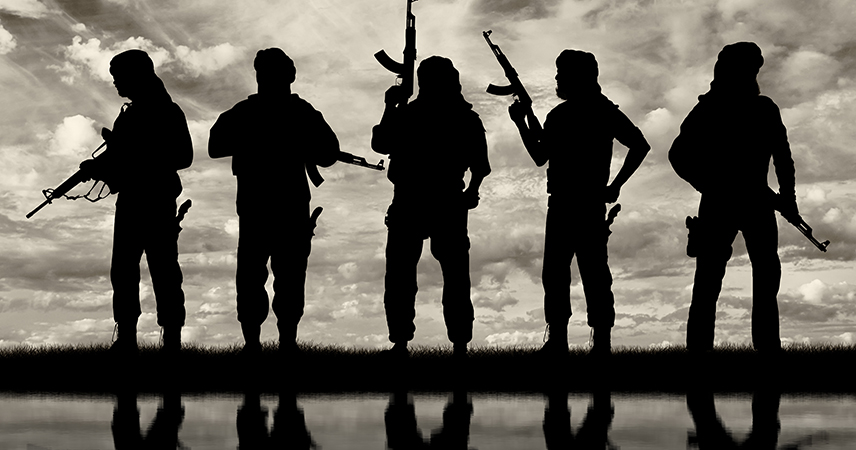Following the sudden collapse of Bashar al-Assad’s regime and the Syria’s entry into, arguably, the most sensitive era since the 2011 protests, the region’s map of influence has taken on a new shape for the first time in nearly five years. Indeed, Hay’at Tahrir al-Sham (HTS) has replaced the fallen regime while the Syrian Democratic Forces (SDF), which serve as the military wing of the Kurdish Autonomous Administration of North and East Syria (AANES), are under significant pressure from Turkish threats and their ally, the Syrian National Army. Meanwhile, ISIS has maintained a dual stance throughout this period, characterized by escalating rhetoric on one hand and low-level operational activity on the other. The question thus remains: How does ISIS interpret the ongoing changes in Syria’s governance structure? And what are the potential scenarios for its interaction with these developments?
ISIS Transformations
The U.S. intervention in Iraq in 2003 to end Saddam Hussein’s rule marked the beginning of a long-term war against jihadist groups, represented by the Iraqi branch of Al-Qaeda led by Abu Musab al-Zarqawi, who was killed in June 2006. At the time, the group controlled vast swathes of Iraq, which emboldened it to declare the so-called "Islamic State of Iraq" in April 2006. After the security situation in Syria deteriorated, the group declared itself the "Islamic State of Iraq and al-Sham" (ISIS) - also known as the Islamic State of Iraq and the Levant (ISIL) - in April 2013 under the leadership of Abu Bakr al-Baghdadi, and it has since been known by its acronym, ISIS.
However, Abu Muhammad al-Julani (Ahmad al-Sharaa), the leader of Jabhat al-Nusra and al-Baghdadi’s representative in the Syrian part of the declared "state," decided to sever ties with al-Baghdadi’s organization and join Al-Qaeda by pledging allegiance to its leader, Ayman al-Zawahiri, in April 2013 as ISIS continued to expand its influence and declared "armed jihad" against al-Julani’s followers in various Syrian cities. In June 2014, al-Baghdadi’s group established the so-called "Islamic Caliphate," based on its interpretation of Islamic political jurisprudence, to delegitimize any organization not under al-Baghdadi’s authority.
The formation of the "Global Coalition to Defeat ISIS" in September 2014, quickly dismantled the "caliphate" project, however. Iraq announced the expulsion of ISIS from its territory in December 2017, and in March 2019, U.S. forces and their ally, the SDF, declared the group’s expulsion from Baghuz, its last stronghold in Syria. Thus, ISIS lost its territorial control and entered a new phase of warfare through scattered and active cells, characterized by hit-and-run tactics, known in jihadist literature as "shawkat al-nikaya wa al-Inhak”, or the power of vexation and exhaustion. These operations, aimed at demonstrating their presence and securing resources, were concentrated in the Syrian desert under the control of the former regime and limited areas within SDF-held territories. Meanwhile, HTS succeeded in pushing ISIS out of its areas and securing itself from the group’s infiltrations, though it revived ISIS’s name in April 2024 when it accused the group of assassinating Abu Maria al-Qahtani, one of its prominent leaders, in Idlib province in northern Syria.
During this period, ISIS remained vulnerable to attacks by the Assad regime, supported by Russian airstrikes, as well as campaigns by the SDF and its allies in the international coalition. The result was a significant depletion of ISIS’s capabilities, with four of its leaders killed within just four years, starting with Abu Bakr al-Baghdadi in October 2019 and ending with Abu al-Hussein al-Husseini al-Qurashi in April 2023. However, the significant geopolitical shift after October 7, 2023, and its regional repercussions impacted Iran’s ability to maintain regional power balances and altered the dynamics of the Syrian scene after Hezbollah entered a full-scale and direct war with Israel. This development was exploited by the Syrian opposition, primarily represented by HTS under its leader Ahmad al-Shara, to advance toward Damascus, which it controlled within just 12 days, forcing Bashar Assad to flee to Moscow on December 8, 2024.
These developments prompted ISIS to anticipate the implications of rapid and profound changes on its future, especially as HTS, accused by ISIS leaders of killing its fourth leader, became a pivotal force in Syria and a focal point of regional and international attention to ensure political transition and intensify the war on terrorism. Therefore, the most significant development for ISIS in the coming period will be the determination of the "hybrid" coalition, composed of local factions and regional and international powers, to eradicate it.
Determinants of the Two Scenarios
ISIS found itself facing a sudden change in the map of influence in Syria and a domestic and international consensus for its eradication. Consequently, the group must choose between two conflicting scenarios: either "mobilization and confrontation" to restore its so-called "caliphate", or "retreat and departure", whereby ISIS would acknowledge the possibility of Syria coming under a single central authority supported regionally and internationally, and avoid uneven confrontations that could end its existence.
1- The "mobilization and confrontation" scenario
This scenario is based on a set of indicators and factors, which can be outlined as follows:
a. A difficult political transition:
b. Escalation of ISIS operations:
c. Potential for exchange of services:
2- The "retreat and departure" scenario
This scenario is based on readings contrary to the above factors, leading ISIS to bet on hiding and finding an alternative refuge to ensure its survival, as suggested by the following:
a. Support for political transition:
The new Syria has received regional and international attention that encourages factions to hand over their weapons and transform into political parties competing for power through electoral programs. It is not in the interest of the West, Turkey, Arab countries, or even Israel for Syria to descend into chaos.
The West wants a new Middle East where Israel has the upper hand, a condition largely met by the fall of the Assad regime. Therefore, it will seek calm to avoid complicating matters in favor of Iran and Russia. U.S. forces, which increased their presence from 900 to 2,000 as announced in December amid indications of efforts to establish a military presence in Ain al-Arab, targeted ISIS positions after the regime’s fall, culminating in the killing of its leader in Syria on December 20, followed by French operations on December 31.
Turkey will not hesitate to prioritize negotiations with the U.S. over disarming the SDF and positioning itself as a trusted interlocutor for the current authority in Damascus and an influential partner in securing the country from terrorism. Meanwhile, Arab countries will support Syria’s transition to counter foreign projects and engage with its new leadership to reintegrate it into the Arab fold.
b. Relativity of reports on ISIS:
Security reports require a "relative" approach, as they failed to estimate the extent of unevenness in power balances following Israeli strikes against the Syrian regime’s army and did not anticipate HTS’s takeover of the country. Some even suggest that figures may be used to serve specific political decisions, such as justifying the continued U.S. presence. Additionally, the new authority in Damascus has experience in dealing with ISIS and enjoys regional and Western support, enabling it to monitor and track the group’s movements, such as thwarting an attempted bombing at the Sayyida Zainab shrine south of Damascus on January 11, 2025.
c. Avoiding losing battles:
Despite claims of ISIS possessing remnants of the former regime’s weapons and Iranian group arms, it is unlikely to initiate confrontation, aware of its limited capabilities compared to the West, which is more determined than ever to silence voices disrupting its Middle East strategy. Therefore, ISIS operations may be limited to sporadic strikes that inevitably end, no matter how painful, with its fighters leaving Syria and the region.
Conclusion
Despite the centrality of Syria in jihadist discourse, ISIS—whose "lone wolf" inspired attacks in Europe and the U.S. have only led to Western policies becoming stricter—will choose departure over mobilization. Consequently, its estimated 2,500 fighters in Syria and Iraq will likely move to the Sahel region where regimes are fragile, and Western interest in their fate is lower. Additionally, ISIS branches are stronger and opportunities for rebuilding are greater and more secure as hinted at in a UN report in January 2024.


